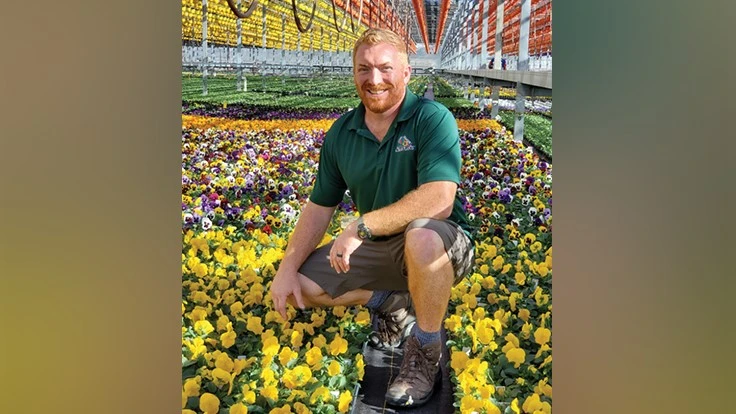

Aaron Bivens initially got into horticulture because he loved plants, but stayed in it because of the people. As head grower at Altman Plants’ Colorado Division and head grower captain for Altman’s entire operation, Bivens combines his passion for gardening with his penchant for teaching.
“It’s a blessing to have this career because I just love plants. That’s what keeps me passionate about [this job],” Bivens says. “But day to day, it’s really the relationships. You get to see employees develop and become better growers, and that’s my favorite part.”
Here’s how Bivens keeps Altman’s growing team on the leading edge of plant production.
Farm raised
Bivens grew up on a farm in northern Illinois, where his family raised corn, soybeans, pigs and cattle. He spent summers baling hay, while helping his mom tend a garden full of everything from pumpkins to petunias.
He started college as an education major, but soon realized how much he missed growing and switched to horticulture. He earned an associate degree of applied science in greenhouse and nursery management from Kishwaukee College in his home state, and then pursued a bachelor of science in general agriculture from Oregon State University.
After an internship at PanAmerican Seed, Bivens gained several years of head grower experience at Tanasacres Nursery in Oregon. That prepared him to start his own nursery in Oregon where he sold plants to independent garden centers, farmers markets and local grocery stores for several years, until the economic decline shuttered his small business.
Bivens worked at Smith Gardens for a few years until the Altman family recruited him — first for their Salinas, California, facility, and then he moved to Peyton, Colorado, in 2015. There, Bivens oversees the 32-acre growing operation from propagation to finished material.
“I call myself a grower, but I don’t really grow anything,” he says. “I orchestrate the growing operation through coaching, guidance, protocols and training. Most of my time is spent organizing and planning to see how everything pieces together in the big picture.”

Scouting for issues
Bivens’ growing team in Colorado consists of five section growers, each with their own assistant grower, zone irrigators and labor leads, as well as a propagation lead and other specialized positions. At peak, it’s about 65 employees.
“I don’t have the ability to meet with 60 people every day,” he says, “so I try to focus my time with the supervisors to streamline communication.”
Bivens walks every zone at least once a week with each section grower to discuss their priorities. “We use a color-coded flagging system, so if something needs to be moved, it gets a red flag. If it needs to be pinched, it gets a purple flag. If it needs a drench, depending on the rate, it gets a different color flag,” he says. Those color-coded tasks keep growers busy while Bivens moves on to other sections.
Regular scouting is vital, in Bivens’ opinion, as it dictates his approach to pest control. With people on site up to 20 hours a day, “spraying to control pests and restricting people from entry into greenhouses can be challenging,” he says. “So, we’re looking at biological pest controls and softer chemistries.”
Since Bivens came to Colorado, he has introduced nematodes and pathogenic fungi and, more recently, persimilis for spider mites and cucumeris for thrips. After a successful trial with these beneficial bugs last summer, he’s been expanding the program. “Using predatory mites seems to be very effective from the standpoint of safety, but also efficacy,” he says.

Cultivating a team
In addition to overseeing production in Colorado, Bivens also serves as head grower captain for Altman’s whole operation. He spends about 20% of his time working with the company’s other head growers to share best practices and maintain consistency.
“The idea is to be someone they can use as a reference or a resource,” says Bivens, who runs a monthly crop protocol call and frequently travels to other locations in Texas and California. “We’re spread out so much across the country that we have to get communication flowing from site to site.”
As much as Bivens loves plants, his role has revealed that his true passion is coaching other growers.

“One of my favorite things to do is to teach people,” he says. “I think it’s important for people to understand why we do things, not just how to do them. So I try to explain why we use this fertilizer versus that one — not just from the standpoint of ‘this one makes it grow more,’ but, ‘this has high or low phosphorus, so this is going to raise or lower pH,’ — constantly trying to reinforce the science.”
But as imperative as technical knowledge can be, Bivens doesn’t want employees to lose sight of the real reason behind their work.
Above all, Bivens says, he’s “trying to instill ownership and pride in the crop. It’s cool to remind your employees that all these poinsettias are going to be on someone’s table for Christmas dinner. It gives value to the job.”

Explore the November 2019 Issue
Check out more from this issue and find your next story to read.
Latest from Greenhouse Management
- Anthura acquires Bromelia assets from Corn. Bak in Netherlands
- Top 10 stories for National Poinsettia Day
- Langendoen Mechanical hosts open house to showcase new greenhouse build
- Conor Foy joins EHR's national sales team
- Pantone announces its 2026 Color of the Year
- Syngenta granted federal registration for Trefinti nematicide/fungicide in ornamental market
- A legacy of influence
- HILA 2025 video highlights: John Gaydos of Proven Winners





